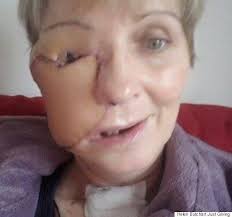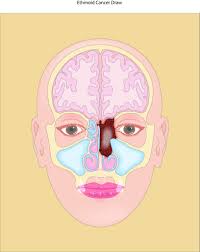
 Represents 5% of all head and neck malignancies.
Represents 5% of all head and neck malignancies.
Paranasal sinus tumor is a cancer that has grow inside the sinuses, the open spaces behind the nose.
Paranasal sinus tumors can originate in the cells of the membranes, bones, or nerves that line the area.
Paranasal sinus cancer most commonly occurs in people between 50 and 70 years old, and occurs twice as often in males as in females.
Symptoms of paranasal sinus cancer may include nasal obstruction and hyposmia early on.
Additional symptoms may develop as malignant cells further grow and spread into other nearby tissue such as the palate or orbital floor.
X-rays of the head and MRI can aid in diagnosis of the cancer.
Tumor resection surgery, radiation therapy and chemotherapy can be used for treatment of the cancer.
Late symptoms include:
Nose bleeds, headaches, blocked sinus, and diplopia.
Risk factors:
Exposure to wood dust or nickel dust, and leather, tobacco use, alcohol consumption.
People with early stage nasal cavity or paranasal sinus cancer often do not show any symptoms, and as a result, these types of cancer are usually diagnosed in the later stages.
Nasal cavity or paranasal sinus cancer is often discovered when a person is being treated for a seemingly benign, inflammatory disease of the sinuses, such as sinusitis.
Signs and symptoms of late stage cancer are generally caused by the spread of malignant cells into the neighbouring structures of the paranasal sinus and nasal cavity.[
The overall signs and symptoms may include sinus pressure and pain, blocked sinus, headaches, nosebleeds, pain and pressure in the ears, among others.
If the tumor spreads into the orbit proptosis, diplopia and other eye problems may appear.
If the tumor spreads into the infratemporal fossa, pterygopalatine fossae or masseteric space, trismus, facial swelling, toothache, mid-face or jaw numbness may occur.
Involvement of the cranium by paranasal sinus tumor may lead to headaches, nerve damage, and cerebrospinal fluid leak.
Risk factors for the development of paranasal sinus tumor:
Cigarettes and tobacco products
Smokers have an excess 20% risk of developing nasal cancer.
There is a positive correlation between the quantity of cigarettes smoked and time period of smoking, and an increased risk of developing nasal cancer.
Quitting smoking decreases the risk.
Secondary smoke exposure has a positive relationship to developing nasal cancer.
The direct contact of tobacco powder with the gums and the mucous membranes of the mouth can largely increase the risk of developing nasal or paranasal sinus cancer.
Environmental factors are likely causes of paranasal sinus and nasal cavity cancer.
Exposure to wood dust and nickel dust, radium fumes, formaldehyde fumes and other substances used in the production of leather and other textiles may also increase the risk, and exposure to air pollution may also increase the risk of getting the cancer.
Consumption of large amounts of salted and smoked food may also increase the risk of developing paranasal sinus and nasal cavity cancer.
Human papillomavirus infection is likely a major cause of paranasal sinus and nasal cavity cancer.
Physical examination may find swollen lymph nodes, or other abnormalities.
No blood or urine tests can diagnose paranasal sinus and nasal cavity cancer.
MRI technology is typically a more efficient method to identify a tumor located in soft tissue and fluid, while CT scans serve to detect damage to bone tissue, especially in the cribriform plate.
Biopsy results determine the final diagnosis of paranasal sinus and nasal cavity cancer.
A nasoscopy can be used as a diagnosis method for paranasal sinus and nasal cavity cancer.
Tissue may be extracted with tools attached to the nasoscope and later examined with a microscope for signs of cancer.
Treatment
The most common approach to treating a paranasal sinus tumor is a combination of surgery and radiation therapy.
Radiation therapy may be given before surgery to attempt to shrink the tumor.
Radiation might also be the main treatment in some cases, such as if a person can’t have or does not want surgery.
Treatment uses methods such as surgery, radiation therapy, chemotherapy and proton therapy.
Surgery is typically followed by chemotherapy and radiation therapy, to kill off any remaining cancer cells.
The type of surgery performed depends on the extent to which cancerous tissue has spread.
A large portion of tissue may have to be removed.
If necessary, a maxillectomy could be used to remove all or part of the maxilla, which includes the hard palate.
More extensive craniofacial surgery can be also used in the treatment of paranasal sinus and nasal cavity cancer, with more extensive tissue removal.
The vacancy created by the removal of tissue can be filled by prostheses or soft tissue.
If the cancer may have spread to the neck, a neck dissection might be performed in order to remove the lymph nodes in the neck area, in order to remove any cancerous cells there.
Radiation therapy is an effective method for paranasal sinus and nasal cavity cancer after implementation of surgery.
Radiation therapy can also be used as an alternative for a patient who is unable to undergo surgery.
For paranasal sinus and nasal cavity cancer, Volumetric Modulated Arc Therapy (VMAT) is consistently and accurately irradiated the target area than Intensity Modulated Radiation Therapy (IMRT).
Tooth decay may be caused by radiation therapy.
Tooth decay from radiation therapy may can be prevented by receiving dental treatment before radiation therapy.
Radiation therapy may cause skin redness and irritation.
Chemotherapy is usually used before or after surgery or radiation therapy.
Possible causes of paranasal sinus tumors:
Exposure to industrial chemicals
Being infected with the human papillomavirus (HPV)
Exposure to wood, leather, flour, textile, nickel, or chromium dust
Exposure to radium
Smoking cigarettes
Early symptoms of paranasal sinus tumors: similar to symptoms of colds or upper respiratory infections.
Blockage of sinuses, or congestion that never goes away
Changes in your voice or breathing
Reduced sense of smell
Headaches
Numbness or pain in face, ears, or teeth
Teeth that become loose
Pus draining from nose or postnasal drip
Frequent nosebleeds
Growth on face or palate
Eyes that continuously water
Bulging eye
Loss of or change in vision
Trouble opening mouth
Staging:
Stage I. The tumor is contained in the sinus and has not spread.
Stage II. The tumor has spread into other parts of the sinus.
Stage III. The tumor has spread into the bone of the sinuses or the eye socket and may have spread to a lymph node.
Stage IV. The tumor has spread deeper into the eye socket, into the brain, or into other parts of the skull and neck, and possibly to more distant parts of the body and may have a larger presence in the lymph nodes.
Complications
Paranasal sinus tumors and their treatment may lead to these complications:
Scarring from surgery
Long-term changes in vision, breathing, speech, chewing, or swallowing, caused by the tumor or surgery
Nerve damage that can affect sensation in your face and movement in your face, shoulder, or arms
Side effects from radiation therapy, such as pain, nausea, trouble eating, mouth sores, loss of teeth, and changes in taste.
Most treatment consists of extensive surgery followed by radiation therapy.
5-year survival 30-79%.
Irradiation can lead to chronic toxicity to optic nerves with an incidence of radiation therapy induced blindness as high as 37% depending on volume, total dose and dose per fraction.
